The Sjogren's Syndrome Market is estimated to be valued at USD 178.5 billion in 2025 and is projected to reach USD 239.9 billion by 2035, registering a compound annual growth rate (CAGR) of 3.0% over the forecast period.
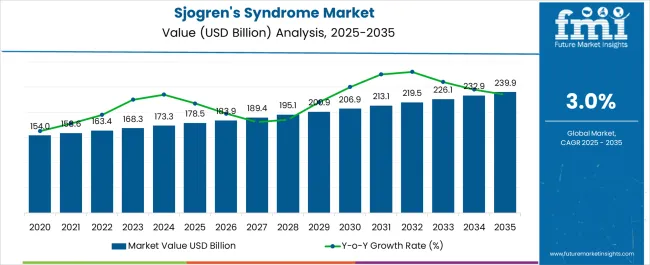
| Metric | Value |
|---|---|
| Sjogren's Syndrome Market Estimated Value in (2025 E) | USD 178.5 billion |
| Sjogren's Syndrome Market Forecast Value in (2035 F) | USD 239.9 billion |
| Forecast CAGR (2025 to 2035) | 3.0% |
The Sjogren’s syndrome market is witnessing steady growth, driven by increasing prevalence of autoimmune disorders and heightened awareness of early diagnosis. Rising patient populations in both developed and emerging regions are influencing demand for more targeted treatment options, including immunomodulators and biologic therapies. Significant progress in clinical research is leading to better understanding of disease mechanisms, which is fostering the development of novel therapies designed to address both systemic complications and quality of life symptoms.
Growing healthcare infrastructure and wider availability of diagnostic tools are contributing to improved detection rates, ensuring broader patient coverage. Regulatory support for orphan drug designation and incentives for rare autoimmune diseases are further stimulating research investments in this therapeutic area.
The increasing focus on personalized medicine and targeted immunotherapies is expected to enhance treatment outcomes while broadening the therapeutic pipeline As awareness campaigns, patient advocacy initiatives, and healthcare spending continue to expand globally, the Sjogren’s syndrome market is positioned for steady long-term growth supported by innovation and unmet clinical need.
The sjogren's syndrome market is segmented by indication type, distribution channel, and geographic regions. By indication type, sjogren's syndrome market is divided into Primary Sjogren’s Syndrome and Secondary Sjogren’s Syndrome. In terms of distribution channel, sjogren's syndrome market is classified into Hospitals Clinics, Public Hospitals, Private Clinics, Retail Pharmacies and Drug Stores, and E-commerce. Regionally, the sjogren's syndrome industry is classified into North America, Latin America, Western Europe, Eastern Europe, Balkan & Baltic Countries, Russia & Belarus, Central Asia, East Asia, South Asia & Pacific, and the Middle East & Africa.
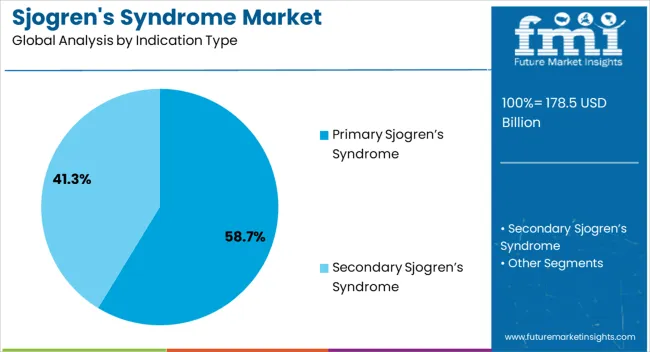
The primary Sjogren’s syndrome indication type segment is projected to account for 58.7% of the Sjogren’s syndrome market revenue share in 2025, positioning it as the dominant category. Its leadership is attributed to the higher prevalence of primary cases compared to secondary forms, which occur in association with other autoimmune diseases. The rising incidence of primary Sjogren’s syndrome across both developed and developing nations has heightened clinical focus on accurate diagnosis and long-term disease management.
Increasing recognition of systemic complications, including fatigue, arthritis, and organ involvement, has underscored the need for more effective treatment pathways. The segment is benefiting from advancements in immunology research that are providing new insights into the pathogenesis of primary Sjogren’s syndrome, thereby encouraging the development of targeted biologics and small molecule therapies.
Patient advocacy groups and healthcare organizations are also contributing by promoting awareness and education, which is leading to earlier detection and greater treatment uptake As ongoing research delivers more refined therapeutic options, this segment is expected to remain the cornerstone of market growth.
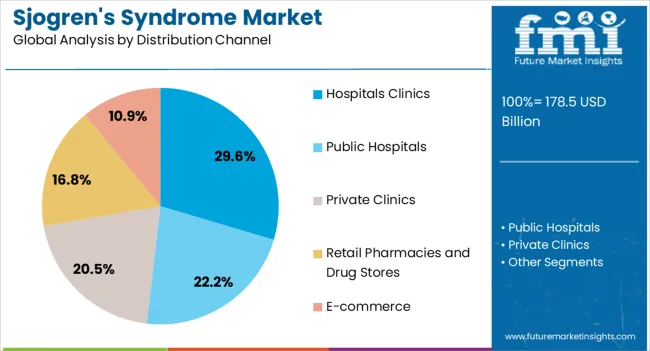
The hospitals clinics distribution channel segment is expected to hold 29.6% of the Sjogren’s syndrome market revenue share in 2025, establishing itself as a significant distribution pathway. Its prominence is being driven by the concentration of specialized healthcare infrastructure within hospital and clinic settings, where accurate diagnosis and comprehensive treatment for autoimmune conditions can be delivered. Patients with Sjogren’s syndrome often require multidisciplinary care involving rheumatologists, ophthalmologists, and oral health specialists, making hospitals and clinics the preferred settings for coordinated management.
The availability of advanced diagnostic tools, infusion therapies, and access to clinical trials further supports the growth of this channel. Rising healthcare investments and the expansion of specialty clinics in emerging markets are improving patient accessibility to treatment.
The hospitals clinics channel also benefits from its role in delivering biologics and advanced immunotherapies, which require professional supervision and monitoring As the complexity of treatment increases and demand for specialized care grows, this segment is expected to strengthen its role as a critical access point for patients.
Sjogren's syndrome is an autoimmune disease which affects exocrine glands, mainly salivary and lacrimal glands, which eventually leads to xerostomia (dryness of mouth) and xerophthalmia (dryness of eyes). Prevalence of the syndrome is higher in female as compared to male. Generally it is observed in age group above 40 years but in cases it has also been observed among children.
The syndrome is also found to be associated with abnormality in connective tissue which leads to rheumatoid arthritis and systemic lupus erythematous. Sjogren's syndrome leads to various complications such as streptococcal, staphylococcal and pneumococcal infections of parotid glands and in some cases it lead to development of parotid tumor.
Complications of lymphomas and neuropathy are also seen in patients with vitamin D deficiency. Although exact cause of the syndrome is unknown, scientists believe it to be a hereditary disorder. Sjogren's syndrome is of two type's viz. Primary sjogren's syndrome and secondary sjogren's syndrome both being systemic disease can affect various systems in body.
Rising number of patient with sjogren's syndrome, increasing awareness about syndrome, growing patient population of several diseases that can causes sjogren's syndrome such as lupus and rheumatoid arthritis, rising demand for advanced treatment for sjogren's syndrome, growing geriatric population, increasing research and development activities and government initiative are some of the factors that drive the growth of the sjogren's syndrome treatment market.
Most of the therapeutics for the sjogren's syndrome are under clinical trials, rigorous research and development activities will launch innovative treatments. The market is expected to grow in North America and Europe regions as compared to Asia-Pacific, Middle East and Africa owing to higher prevalence rate.
More epidemiological studies will revile prevalent regions to be tapped in the near future. The companies operating in dry eye condition, symptom of sjogren's syndrome are entering into the mergers and acquisition with other companies to expand its product offerings in dry eye syndrome treatment segment.
For instant, in 2025, Nicox S.A. a pharmaceutical company based in France launched AdenoPlus and Xailin. In addition, in June 2025, Allergan plc, completed acquisition of Oculeve Inc, a medical device company that emphases on novel technologies for dry eye to develop its business in the dry eye syndrome treatment market.
In October 2025, Allergan, Inc. introduced synthetic tear REFRESH OPTIVE gel drops to deliver artificial tear alternative for relieving dry eye symptoms.
Depending on geographic regions, global sjogren's syndrome treatment market is segmented into seven regions: North America, Latin America, Western Europe, Eastern Europe, Asia Pacific Excluding Japan, Japan and Middle East & Africa. The global sjogren's syndrome treatment market is anticipated to register a healthy CAGR during the forecast period.
North America followed by Europe dominates the global sjogren's syndrome treatment market due to increasing number of geriatric population with sjogren's syndrome and deployment of advanced healthcare infrastructure facilities.
Asia-Pacific is emerging market for global sjogren's syndrome treatment market due to developing healthcare infrastructure, rise in cases of sjogren's syndrome, increasing disposable income and rising patient population suffering from autoimmune disease that can cause sjogren's syndrome and rising government spending in healthcare industry in this region.
The report is a compilation of first-hand information, qualitative and quantitative assessment by industry analysts, inputs from industry experts and industry participants across the value chain.
The report provides in-depth analysis of parent market trends, macro-economic indicators and governing factors along with market attractiveness as per segments. The report also maps the qualitative impact of various market factors on market segments and geographies.
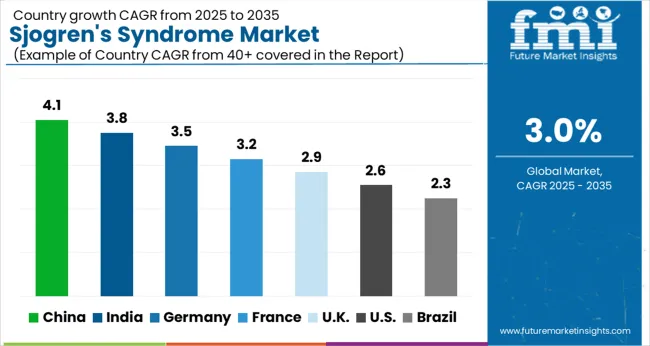
| Country | CAGR |
|---|---|
| China | 4.1% |
| India | 3.8% |
| Germany | 3.5% |
| France | 3.2% |
| U.K. | 2.9% |
| U.S. | 2.6% |
| Brazil | 2.3% |
The Sjogren's Syndrome Market is expected to register a CAGR of 3.0% during the forecast period, exhibiting varied country level momentum. China leads with the highest CAGR of 4.1%, followed by India at 3.8%. Developed markets such as Germany, France, and the U.K. continue to expand steadily, while the U.S. is likely to grow at consistent rates. Brazil posts the lowest CAGR at 2.3%, yet still underscores a broadly positive trajectory for the global Sjogren's Syndrome Market. In 2024, Germany held a dominant revenue in the Western Europe market and is expected to grow with a CAGR of 3.5%. The U.S. Sjogren's Syndrome Market is estimated to be valued at USD 64.8 billion in 2025 and is anticipated to reach a valuation of USD 83.4 billion by 2035. Sales are projected to rise at a CAGR of 2.6% over the forecast period between 2025 and 2035. While Japan and South Korea markets are estimated to be valued at USD 9.3 billion and USD 5.3 billion respectively in 2025.
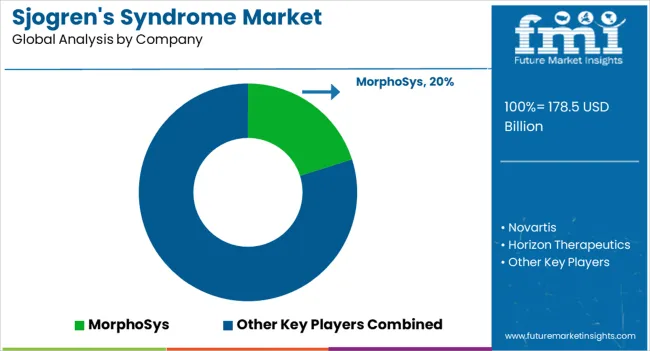
| Item | Value |
|---|---|
| Quantitative Units | USD 178.5 Billion |
| Indication Type | Primary Sjogren’s Syndrome and Secondary Sjogren’s Syndrome |
| Distribution Channel | Hospitals Clinics, Public Hospitals, Private Clinics, Retail Pharmacies and Drug Stores, and E-commerce |
| Regions Covered | North America, Europe, Asia-Pacific, Latin America, Middle East & Africa |
| Country Covered | United States, Canada, Germany, France, United Kingdom, China, Japan, India, Brazil, South Africa |
| Key Companies Profiled | MorphoSys, Novartis, Horizon Therapeutics, Janssen Research & Development, Advanz Pharma, Daiichi Sankyo, and Resolve Therapeutics |
The global sjogren's syndrome market is estimated to be valued at USD 178.5 billion in 2025.
The market size for the sjogren's syndrome market is projected to reach USD 239.9 billion by 2035.
The sjogren's syndrome market is expected to grow at a 3.0% CAGR between 2025 and 2035.
The key product types in sjogren's syndrome market are primary sjogren’s syndrome and secondary sjogren’s syndrome.
In terms of distribution channel, hospitals clinics segment to command 29.6% share in the sjogren's syndrome market in 2025.
Explore Similar Insights

Thank you!
You will receive an email from our Business Development Manager. Please be sure to check your SPAM/JUNK folder too.
Chat With
MaRIA